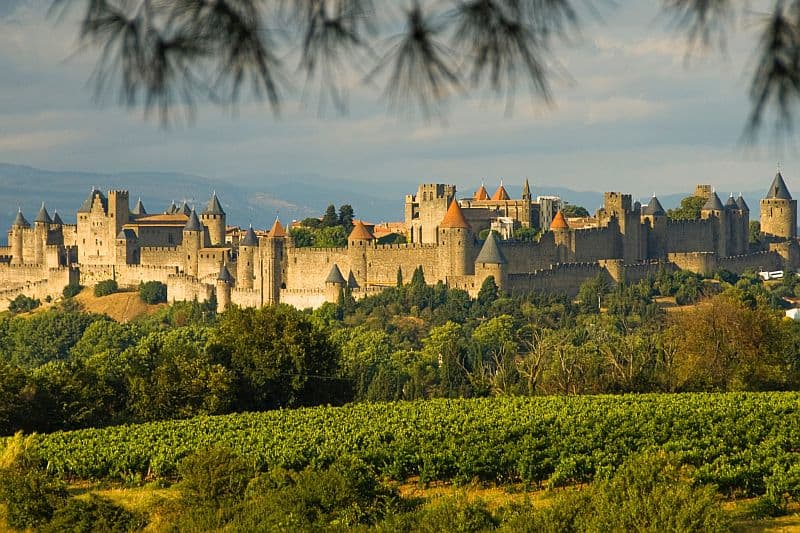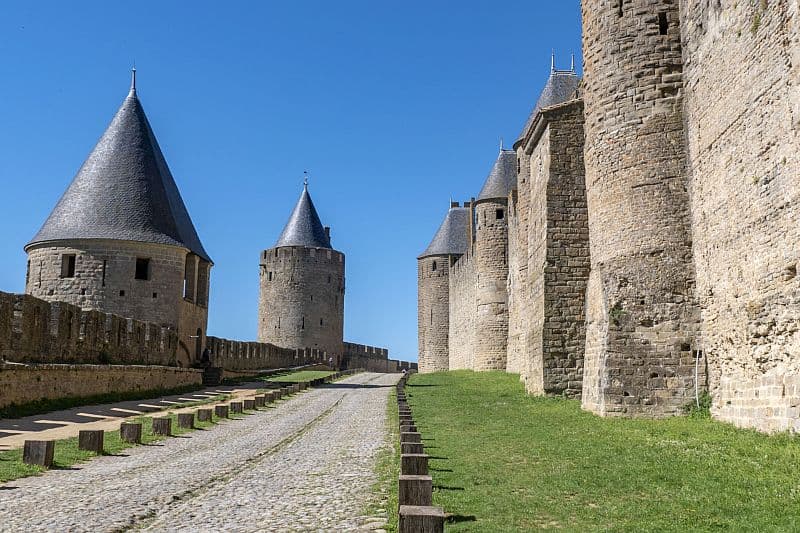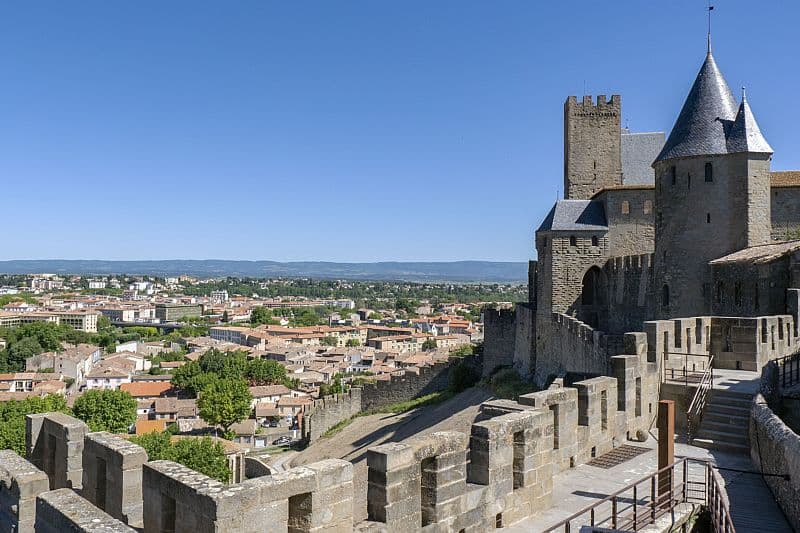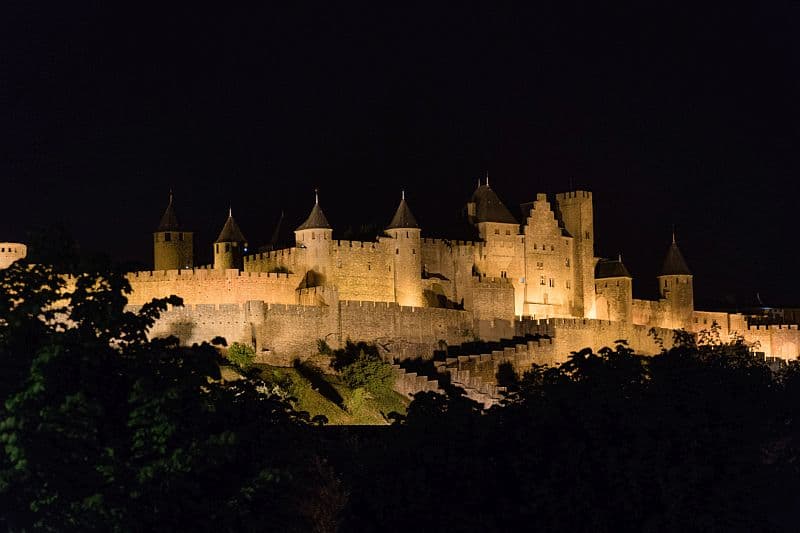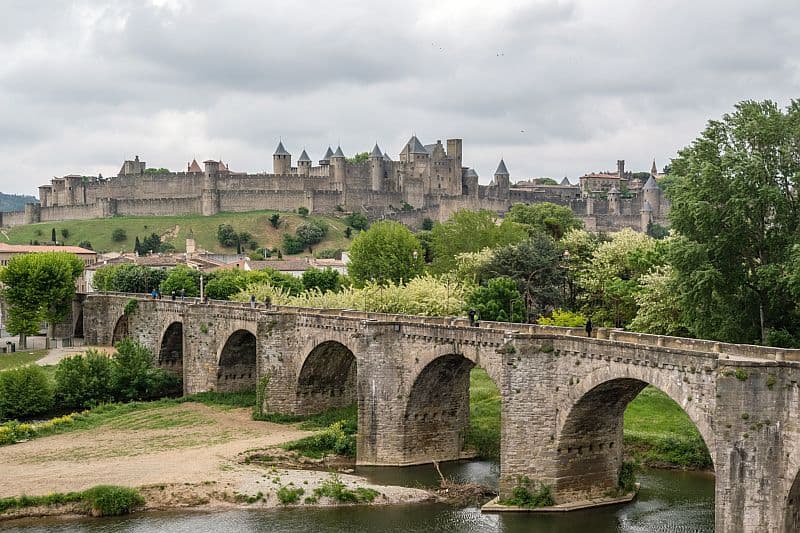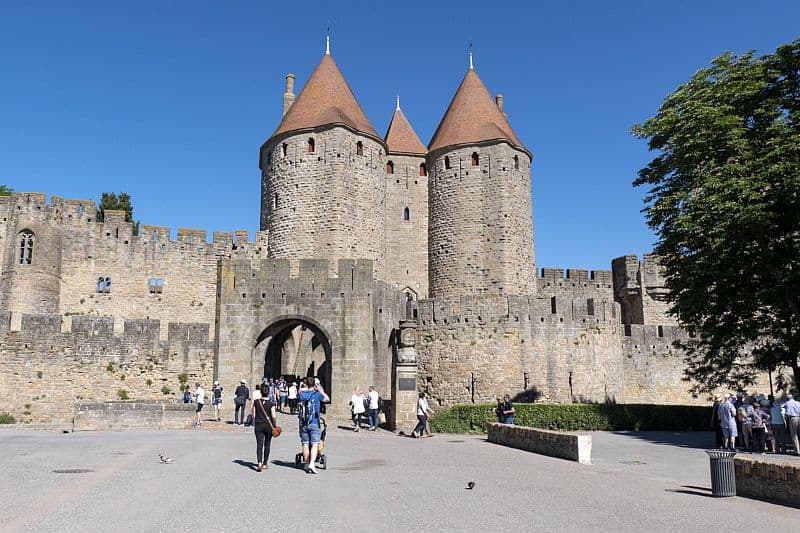If you love castles and beautiful landscapes, then the spectacular fortress of Carcassonne is definitely worth visiting. Carcassonne castle is the best-preserved medieval fortress in the world and has served as inspiration for countless castles that have been invented in fairy tales.
Carcassonne boasts magnificent ramparts with watchtowers, a portcullis, a drawbridge, and elevated defences built on top of a hill. During its almost two-thousand-year-old history, Carcassonne fortress has resisted many armies and witnessed numerous battles.
Where is Carcassonne?
Carcassonne is located fifty miles south-east of Toulouse in the Aude region of France. The fortress occupies land near the Pyrenees Mountain range and formerly bordered the Spanish region of Aragon.
What is Carcassonne Famous For?
- Carcassonne has 3 kilometres of external walls!
- The medieval fortress has 52 watchtowers on its ramparts.
- There is a boardgame named after Carcassonne.
- 4 million people visit Carcassonne every year.
- Only around 50 people live in Carcassonne castle.
- Carcassonne was used as a location for the 1991 film, ‘Robin Hood: Prince of Thieves’.
What can you do in Carcassonne?
Carcassonne is situated in a picturesque rural landscape and can be admired against the spectacular backdrop of the Pyrenees. The best place to see Carcassonne is from the historic Pont-Vieux bridge over the river Aude. This location is far superior to any other for capturing magical photographs of the fortress. If you stay into the evening, make the most of your trip by seeing Carcassonne castle illuminated from afar.
Entering through the portcullis, visitors can weave their way through the Medieval city with its narrow, cobbled streets, lined with gift shops and restaurants. Climbing to the top of the ramparts, you will be greeted with stunning panoramic views of the canal and surrounding landscapes. Guests can wander the battlements, ascend the parapet, and see some of the rooms in the keep. Don’t miss the opportunity to see the Pyrenees Mountains from the highest position in the area!
What are the Origins of Carcassonne?
Carcassonne was founded in the 6th century BC by a people of Celtic origin. Having been transformed into a hill fort named ‘Carsac’, the Romans fortified the city in the 1st century AD. Over hundreds of years, the name of the city changed to ‘Carcasum’, and it grew to be a successful trading post during its occupation by the Gallo-Romans.
In 462 AD, Carcassonne was taken by the Visigoths, marking the beginning of its history as a tactical fortress that would be fought over by many armies. To give the town protection from invasion, the inner rampart of the city was built. Invasion came again in 725 AD, and this time, Carcassonne was seized by a Saracen army from Barcelona. After being held by the Saracens for 35 years, the fortress was taken back under French control by the King of the Francs, Pippin III.
How did Carcassonne become a Medieval Stronghold?
During Medieval times, Carcassonne became recognisable as the fortified stronghold that can still be seen today. Throughout the period, Carcassonne castle was mostly owned by Frankish nobility. During the 11th century, the keep was built to provide accommodation for the viscounts of Carcassonne and Bézier, who chose the city as their home. At this time, a basilica, and the Château Comtal was built inside the city walls.
However, Carcassonne’s peace was interrupted again by the Albigensian Crusades. The viscounts of Carcassonne and Bézier belonged to a religious group known as the Cathars, or Albigenses. French Catholics were unsettled by Cathars because they did not recognise them as Christians.
In 1209, the Cathars of Languedoc were overthrown and were forced into surrendering the city of Carcassonne. The unfortunate Viscount, Raymond-Roger de Trencavel, was imprisoned in his own dungeon during negotiations, and apparently starved to death three months later. The citizens of Carcassonne were expelled from the city and Simon de Monfort was appointed as Viscount. Trencavel’s son attempted to recapture Carcassonne but was defeated, and in 1247, the viscounts’ possessions were confiscated by the French crown.
The thirteenth century marked a new era for Carcassonne as it was modernised, and Gothic construction was undertaken on the cathedral. By the end of the thirteenth century, Louis IX had commanded the construction of the outer ramparts, and then Philip III added fortifications to the inner walls. The space between the walls extends for a little over one kilometre and was designed to delay attacking forces if they made it through the outer defences of the fortress. However, during medieval times, this area was inhabited by the poorest people of the city, who lived in shanty towns that have long since gone.
Because of its important position on the border with Spain, the castle of Carcassonne was seen as a great tactical stronghold. In 1355, Edward the Black Prince failed to take the city during the 100 Years War with England. Carcassonne castle remained in French hands, but its significance was greatly reduced after 1659.
What Happened to Carcassonne after Medieval Times?
In 1659, Carcassonne became less important as a French fortress. The Treaty of the Pyrenees changed the border between Spain and France by giving the latter the region of Roussillon. No longer occupying a tactical position, Carcassonne became a manufacturing centre for the Languedoc wool industry.
In the eighteenth century, Carcassonne’s significance declined still further when trade with the Ottoman empire collapsed. Henceforth, the city of Carcassonne became a rural outpost that fell into a state of disrepair.
Eugène Viollet-le-Duc was a renowned architect and restorer who rescued Carcassonne Castle in the nineteenth century. He undertook work on the fortress to repair and preserve its fortifications and buildings. As a result, UNESCO declared Carcassonne a designated World Heritage Site in 1997.
Cruise the Canal Du Midi with European Waterways
European Waterways takes you on an exclusive tour of the Languedoc region on hotel barges Anjodi, Enchante and Athos. Navigate the Canal du Midi for a unique experience of the rural landscapes of France. From the comfort of your barge, see Carcassonne situated on its idyllic hilltop surrounded by stunning views, and then visit the fortified city itself before you return for a luxurious evening onboard.
For more information on our itineraries and the rest of our collection of luxury hotel barge cruises, why not order a free copy of our brochure today or speak to a member of our team directly using our handy Contact Form.
 English
English
 Spanish
Spanish French
French German
German Norwegian
Norwegian Portuguese
Portuguese Swedish
Swedish Italian
Italian Russian
Russian Simplified Chinese
Simplified Chinese Japanese
Japanese
